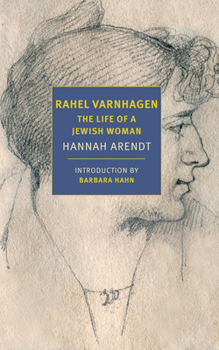Rahel Varnhagen: The Life of a Jewish Woman
Select Format
Select Condition 
Book Overview
A biography of a Jewish woman, a writer who hosted a literary and political salon in late eighteenth- and early nineteenth-century Germany, written by one of the twentieth century's most prominent intellectuals, Hannah Arendt. Rahel Varnhagen: The Life of a Jewish Woman was Hannah Arendt's first book, largely completed when she went into exile from Germany in 1933, though not published until the 1950s. It is the biography of a...
Format:Paperback
Language:English
ISBN:1681375893
ISBN13:9781681375892
Release Date:February 2022
Publisher:New York Review of Books
Length:272 Pages
Weight:0.68 lbs.
Dimensions:0.7" x 5.0" x 7.9"
Customer Reviews
2 ratings
Identity
Published by Thriftbooks.com User , 15 years ago
The subject originated the Goethe cult in Berlin. Rahel wished not to soil the purity of life's happenstance. Arendt claims that German-speaking Jews were unique. This book is a contribution to the complex problem of assimilation. Rahel had extraordinary intelligence and a typical romantic personality. Rahel Varnhagen was born in 1771 in Berlin and died in 1833. Reason may liberate the past and guide the future. Rahel had a sense of inferiority. Enlightenment teachings showed a way to move beyond mere facts. Rahel had an inclination to generalize. Women were the agents of social assimilation at the time. In the Enlightenment the nobleman was being reduced to the bourgeoisie. Berlin was bourgeois. Rahel had a relationship with Count von Finckenstein which failed. He pulled away from her. Facing unhappiness and disgrace, Rahel felt marked. She was ashamed of unhappiness, of ugliness. She went to Paris in 1800. Bitterness was a consequence of melancholy. She fell in love. Anti-Semitism spread through the Prussian provinces at the beginning of the nineteenth century. Rahel lacked grace through a lack of position. She was an outsider and without modesty. Rahel urged an unhappy friend to read Goethe as one would read the Bible, as a mediator. Through Goethe Rahel was forced to bow to objective reality. In the Spring of 1808 Rahel met August Varnhagen in Berlin. He was rational, teachable, and fourteen years younger. When she criticized he was not offended. In 1814 she married Varnhagen. A chronology appears at the end of this marvellous book. It is not a typical biography. Arendt is more concerned with mind, emotion, and societal setting than the usual biographer.
Must read for any Arendt Fan
Published by Thriftbooks.com User , 21 years ago
Intertwining Identities Hannah Arendt's Rachel Varnhagen: The Life of a Jewess is the biography of Varnhagen that simultaneously attempts to define Rahel Varnhagen's gender and national identity as a resident in early 19th century Germany in Varnhagen's own terms, while Arendt refines her political theory. Rachel Varnhagen is portrayed throughout the book as a complex character; a Jewish woman in a German society at the dawn and immediate following years of the Napoleonic Revolution. Arendt is an accomplished political-philosopher who despised being called a philosopher. Arendt's rise to academic prominence came when she wrote Eichmann in Jerusalem; Eichmann was where she coined the phrase "banality of evil" in reference to the famous trial of the Nazi Adolph Eichmann. Arendt was on assignment in Jerusalem for the Eichmann trial as a reporter for Harper's because she could not attain a university teaching position. Arendt had not successfully completed the monograph that was to be her Ph.D. dissertation. During the National Socialist ascension to power in 1933 Arendt was forced into exile, therefore hindering the completion of the biography of Varnhagen and her doctoral dissertation. Arendt studied under Karl Jaspers and Martin Heidegger the later of which she had an affair. She is most known in political philosophy circles for her study of totalitarian regimes in Origins of Totalitarianism. Arendt collected the published and unpublished letters of the famous salon, bourgeoisie-oriented Varnhagen to map Varnhagen's identity through the inner voice she reveals in her letters. Through reading the letters it is evident that Varnhagen is practically apolitical, but she struggles with her German-Jewish identity and her life as a woman. Arendt explores the complexities of this dynamic through attempting to slip into Varnhagen and convey to the reader Varnhagen's existence. While in the process of amalgamating the various stories of Varnhagen, Arendt also devises her political theory.Varhagen was at the center of an aristocratic salon where literature and culture were often discussed and she was viewed as a Jewish exception to anti-Semitism. It was believed at the beginning of the nineteenth century that all anti-Semites had their exceptional Jew, and for the many attendees of Varnhagen's salon it was Rahel. In adding her political theory into the construction of Varnhagen's biography Arendt spares Varnhagen no sympathy, often thinking that these very exceptions furthered the anti-Semitic cause. In essence what Arendt has done is constructed a philosophical-psychological biography delving into the subject's mind, breaking the barrier between subject and observer by using the letters as a background to reconstruct the thoughts of Varnhagen. Varnhagen wrote her letters as a narrative, waiting and watching for life to unfold, unwilling to participate in introspection. Fearing that contemplation of the past might lead to her rejecting





